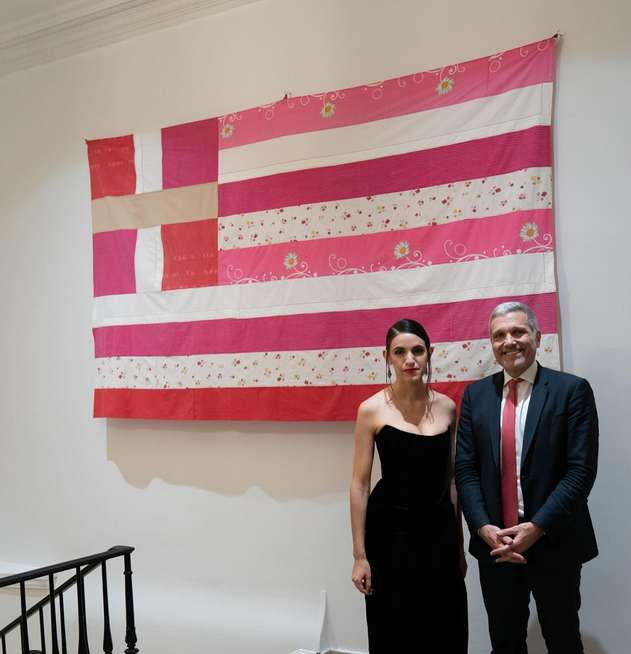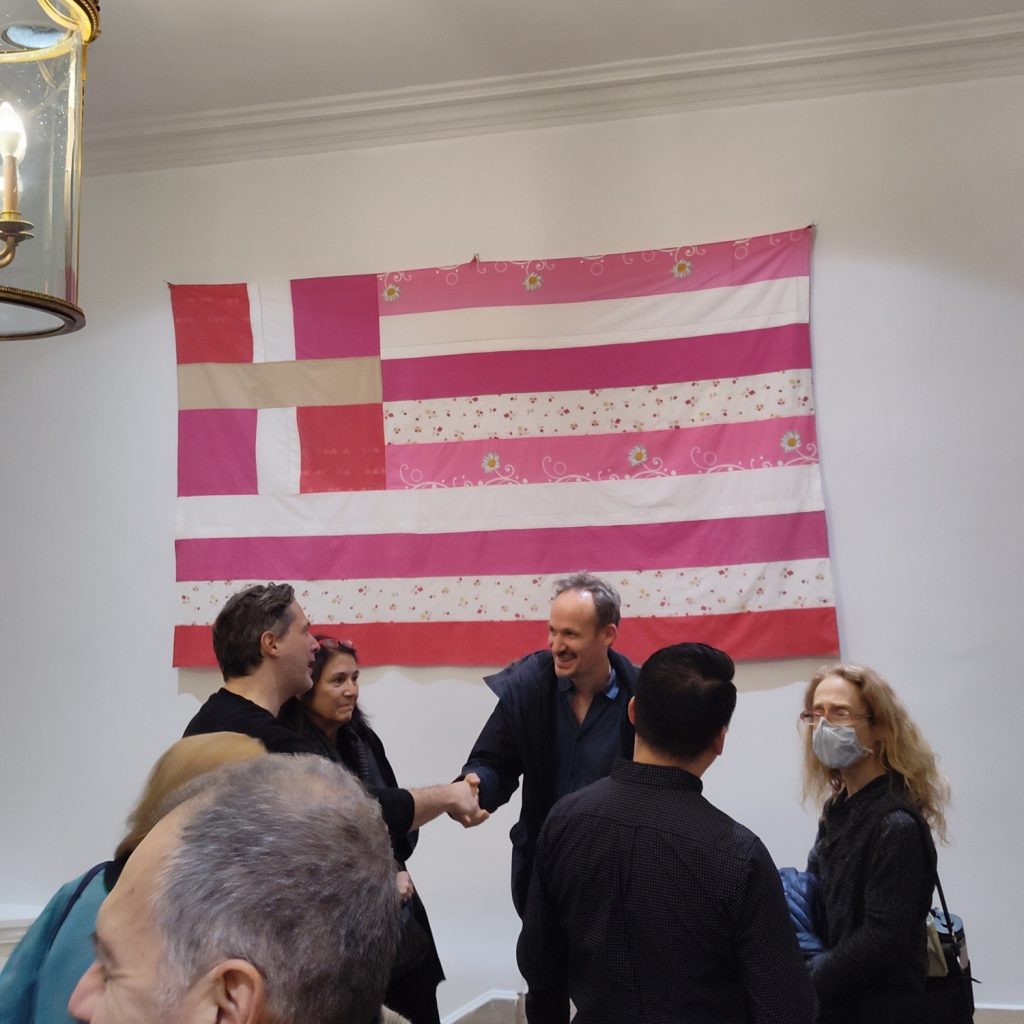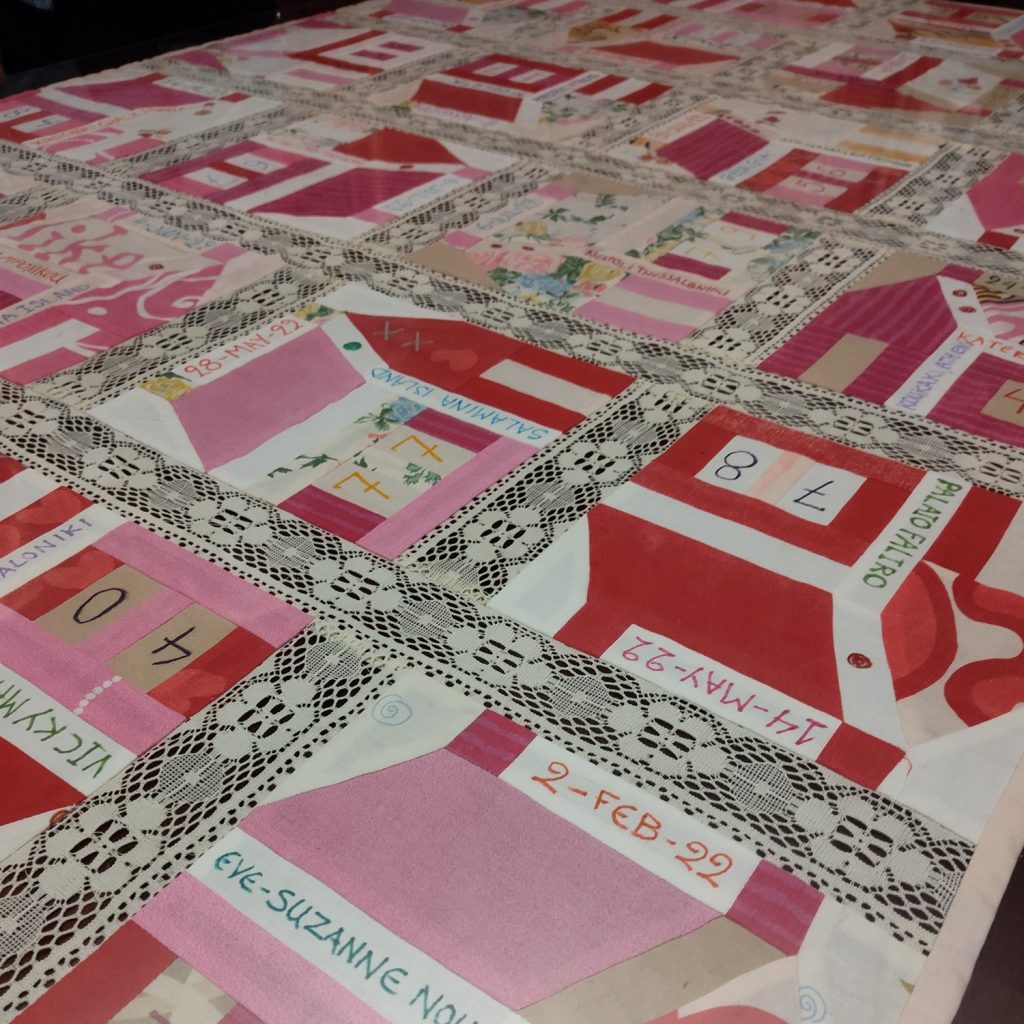Last Friday, December 15, 2023 we gathered to celebrate the opening of a meaningful exhibition of work by Georgia Lale. Our joy quickly dwindled as in the following days the Consulate and artist received intense reactions and criticism over one of the two pieces in particular, leading to the work’s censorship and removal.
Before getting into the latest unfortunate update, we would like to preface this letter by sharing more information about the work, the process, their meaning, and what made them so powerfully moving. In doing so, we hope to explain why we at peri-Tēchnes irrevocably stand by the artist and the Consulate’s team that played a part in the setting up of the exhibition.

Artist Georgia Lale with the Consul General Konstantinos Konstantinou posing in front of one of the two pieces exhibited.
Georgia Lale is a multidisciplinary artist and cancer fighter based in New York. The activist nature of her work served as the initial draw to her as we got to talk with her during the pandemic (virtually of course). At the time, her oeuvre focused on inequalities and shortcomings of access to healthcare in the US. The artist’s calm demeanor and passionate way of speaking about topics revolving around human rights earned her a spot in our hearts.
The exhibition that opened on December 15th at the Consulate General of Greece in New York is titled Neighborhood Guilt. It displayed two pieces of meticulously hand-embroidered works by Georgia Lale. The exhibition’s subject is the ever-rising numbers of domestic violence and femicides in Greece and internationally. In this context, Lale focused mainly on Greece from where she comes.
Upon entering, the first piece you encountered was a large recreation of the Greek flag sewn from pieces of sheets. These were sheets mailed to the artist from victims of domestic abuse. The caveat was that the artist had requested that any sheets shared with her were meaningful to their owners and had once been dreamt upon.

As the artist shared at the opening:
She was surprised by the prevalence of the colors pink and white in the sheets mailed to her alongside the notes the owners sent her sharing the stories and contexts behind their choices.
The piece re-creating the flag, was a memorial to all abuse and femicide victims, and especially to Caroline. Caroline was a victim who perished on her very own bed at the hands of her husband. She was left lying there beside her infant daughter — a story that shook everyone during the summer of 2021. The artist, following a pattern not foreign to artistic productions across eons of time, used the flag as a powerful symbol of shared responsibility in creating a safer and more equitable society for everyone. As several artists who have used the flag as a trope and symbol have mentioned:
When used in the context of art, flags become powerful references not only to the society they represent but also to the individual observing the work. Societies comprise countries, and individuals comprise societies. This makes flags a strong tool in showing the unbreakable links between the individual and the whole and the notion of collective responsibility.

This takes us to the second piece (seen above), which is a patchwork that repeats the pattern of homes. The artist chose the home as a pattern deliberately and mindfully. Cases of domestic abuse and femicide take place predominantly in the victims’ homes and beds. Each house displays the name, age, date of passing, and location of victims of 2022. What makes the work even stronger is noticing the variety of ages and locations emphasizing that the common denominator is, in fact, the feminine gender. Age and location have little to do with the growing femicide phenomenon.
This brings us to today…
The flag piece has now been removed from the Consulate at the orders of the Ministry of Foreign Affairs in Greece. The censorship occurred after an uproar fueled by a member of the Greek parliament and a member of the Greek-American press filed public complaints making references to defamation and defiling the flag.
It is curious how there seems to be a broader tolerance over the repurposing of the Greek flag and even letters of the Greek alphabet usually for advertising purposes. Yet, in the case of Neighborhood Guilt, we found ourselves in front of artwork that could truly generate motivation in all of us to be better constituents, neighbors, and dare we say patriots by working to create a society that is safe for all people, a society that would not need another piece like this in the first place.
This entire situation makes it worth asking ourselves and each other how we have reached a point where we care more about objects than we care about our fellow humans.
How have we reached a place where we are unable to sit with our discomfort when presented with our collective responsibility in the state of our society where femicides are growing in numbers?
How is it that we turn a blind eye to the repurposing of flags when monetary gain is involved yet take offense at doing so to raise awareness of an issue that should terrify us all?
And finally, how is it that we stand today and tolerate the censorship and removal of artworks from anywhere in the context of the democratic and free societies that we so like to boast of?
In closing
Let us all keep in mind that “liking” how a piece looks is a secondary or tertiary component in the true value of artistic production. Art, from its inception, was and remains a communication tool. And like with all communication, you do not need to like or agree with what someone says to be able to hear and think and process it. This is what we were taught in school is defined as critical thinking.
Might this event, if nothing else, urge us all to rekindle and sharpen our abilities to think critically and sit with what makes us uneasy, before reacting and spreading hatred and chaos.
With respect,
The editorial contributors to peri-Tēchnes
A few additional sources:
– designboom
– Lifo (1)
– Lifo (2)
– Elle.gr + official artist statement